Sony Cyber-shot DSC-T11 Digital Camera
2005-05-11
Last week, I was fortunate enough to receive the Sony Cyber-shot DSC-T11 digital camera from my uncle. He traveled from Taiwan to visit us and bought this camera from Japan. I am very fortunate because not only did he bring me this fantastic gift all the way from overseas, this gem is unavailable through proper channels in the United States. I am very grateful for his giving.
The Sony Cyber-shot DSC-T11 digital camera was introduced last year in Japan. Due to a small defect, Sony had stopped its production. (I don't really know what the defect is, but please enlighten us if you do.) By now, the defect is fixed and the DSC-T11 is once again being sold in Japan, with no news of it being sold in the United States. Instead, Sony offers the very similar Cyber-shot DSC-T33 digital camera for the US market.
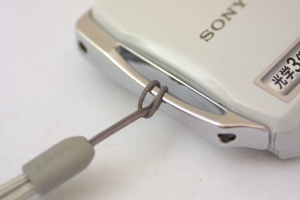
The Sony Cyber-shot DSC-T11 is closely based on the Sony Cyber-shot DSC-T1. They both have the slim rectangular form factor, the right-angle 3x optical zoom technology, the big 2.5" LCD in the back, provides 5.1 megapixels, and uses the Memory Stick DUO storage cards. The only difference is that the new DSC-T11 did away with the sliding lens cover, a larger strap attachment, and is available in white instead of silver. The rear button layouts are exactly the same between the two models.
Mini-Review: Lens
It is quite amazing that the Sony Cyber-shot DSC-T11 sports a 3x optical zoom in such a slim package. Although other manufacturers have pioneered this technology in their digital cameras, I am still quite amazed looking at the DSC-T11. The zoom range is equivalent to 38 - 114 mm in 35mm film format. The lens sport a f/3.5 - f/4.4 aperture, depending on which end of the zoom the lens is at.

The Carl Zeiss Vario Tessar made lens is really quite good. When I looked at the pictures I shot on the LCD, while visiting the Palos Verdes cliffs, I wasn't at all impressed. They seemed a little washed out, flat, and low contrast. But when I finally pulled up the picture on my computer, my jaws dropped. The pictures are highly saturated, exposure was spot on, sharpness was excellent, and the contrast was good! The camera rendered the sunset well. The coastal picture I shot is going into my portfolio. It has already found a home on my Windows XP desktop background.
Unlike other P&S digital camera, the DSC-T11 doesn't have lens cover. And Sony had done away with the sliding lens cover that was present on the predecessor. Although I never ever use a lens cover during a photo shoot, I feel attaching a lens cover during storage is a must. I suppose if the camera is always stored in the included pouch, dust and scratch is not much of an issue. But the camera being so thin, it's tempting to place it in my tuxedo pocket without the pouch (which I did this past weekend). I feel Sony can improve this design by allowing a lens cap in the future.
Mini-Review: Size
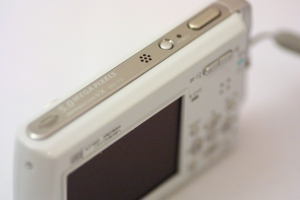
As I alluded to earlier, the DSC-T11 fits very well in the pocket of my tuxedo jacket pocket. It has a very flat and slim profile. In fact, it was so slim that I had forgotten it was in my pocket through out the reception. Needless to say, with its thinness and all the distraction, I had forgotten to shoot any pictures with it at the party. Although it is thinner, it is twice as tall as my wife's Sony Cyber-shot DSC-U30 digital camera. Sony had to make it this tall to host the large 2.5" LCD and the 3x optical zoom. At first, my wife was turned off by its size compared to her DSC-U30. But after seeing how well it fits in my pocket, she has decided to move up to the DSC-T11 by taking it from me.
Mini-Review: Battery Pack and Storage Card
Like many point-and-shoot digital cameras today, the battery pack and the Memory Stick Duo storage card shares the same compartment on the DSC-T11. The Memory Stick Duo slides in and locks. To remove it, you press it again and slide it out. The battery pack, on the other hand slides in easily. When you open the compartment to change memory cards, it's possible for the battery to slide back out. Therefore, you have to open the compartment with the digital camera upside down. It would be nicer if Sony had designed a locking mechanism for the battery as well.
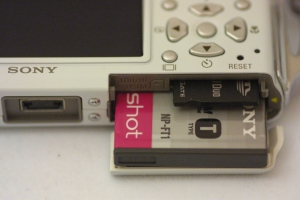
The DSC-T11 can use Memory Stick Duo or Memory Stick Pro Duo. The Duo format is a smaller size of the regular Memory Stick. Its size is similar to the SD cards. The Pro cards have higher storage limit, allowing you to have gigabytes of storage. A 32 MB Memory Stick Duo is included. Because the DSC-T11 stores its 5.1 MP images in JPEG format, you can store about 16 pictures, at 2 MB each, on the 32 MB card. A Memory Stick adapter is included so that you can insert the Memory Stick Duo into your Memory Stick reader or other digital cameras and camcorders that use Memory Stick.
A Sony infoLithium NP-FT1 battery pack is include with the DSC-T11 digital camera. It's a rectangular proprietary battery rated at 3.6 volts for 2.4 Wh. Because this camera has no optical viewfinder and uses the large LCD as its electronic viewfinder, I was afraid that battery life is short. But after a few days of snap-shooting here and there, I haven't yet had to recharge the battery pack. It seems that the battery capacity is sufficient for general use.
Mini-Review: Docking Cradle UC-TB
I don't typically use the docking cradles that come with digital cameras. So I haven't paid much attention to the Sony UC-TB USB Cradle that with the DSC-T11 digital camera. That is until today, after a recent break-through occurred in the "using Sony digital camera as a picture viewer" thread, when I decided I could use the cradle to turn the DSC-T11 digital camera into an electronic picture frame.
The Sony UC-TB USB Cradle serves several purposes: 1) holds the DSC-T11 upright on your desk; 2) charges your DSC-T11 digital camera; 3) provides an USB interface to your computer; and 4) provides audio/video (A/V) output in mono to your television. Out of these four functions, one and two can be done without the cradle.
The top of the cradle is the digital camera holder and provides the proprietary interface to the digital camera (see picture below). Simply pushing the digital camera onto the cradle causes it to click in securely.
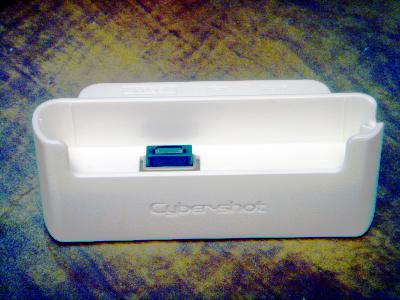
The back of the cradle has three ports: A/V Out (MONO), USB Type B, and the Sony proprietary port for plugging in the AC adapter (see picture below). It's disappointing to note that the USB cradle doesn't have a tripod socket.
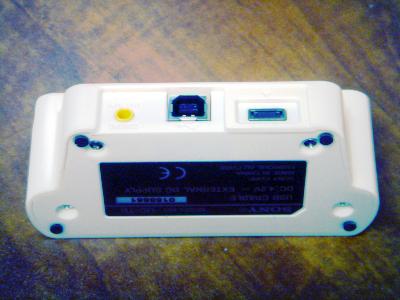
The DSC-T11 digital camera feels nice and comfy in the docking cradle. Because the DSC-T11 is made out of die-cast metal and painted white, while the docking cradle is made out of white plastic, they feel slightly mismatched when the camera is docked.
Related Links
- DCRP Review: Sony Cyber-shot DSC-T33
- Sony Cybershot DSC-T1 5MP Digital Camera with 3x Optical Zoom - Amazon User Reviews
- Sony Cybershot DSCT33 5.1MP Digital Camera with 3x Optical Zoom (Includes Docking Station) - Amazon User Reviews
- Sony NPFT1 InfoLithium Rechargeable Battery Pack for the DSCT1/T33/L1/M1 Digital Cameras - Amazon User Reviews
$10000-above
$5000-$9999
$2000-$4999
$1000-$1999
$500-$999
$200-$499
$100-$199
$50-$99
$25-$49
$0-$24
Gift Certificate

